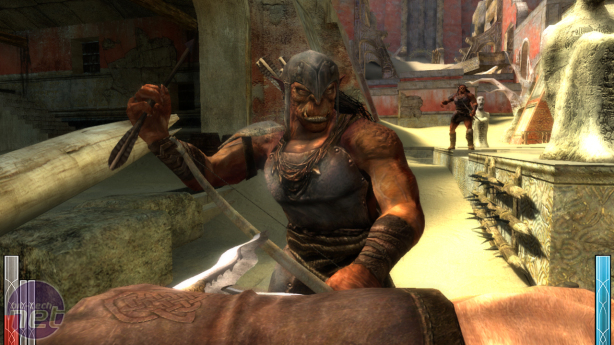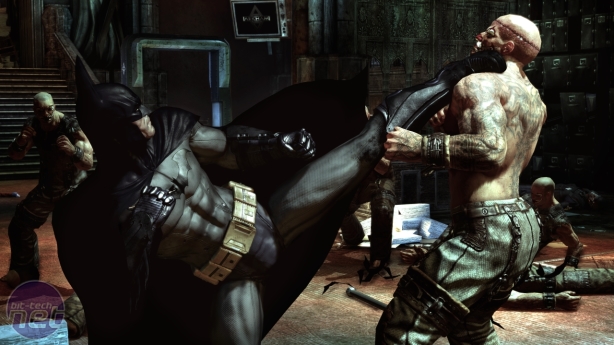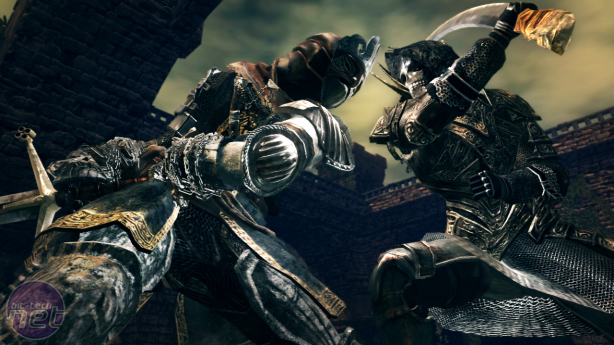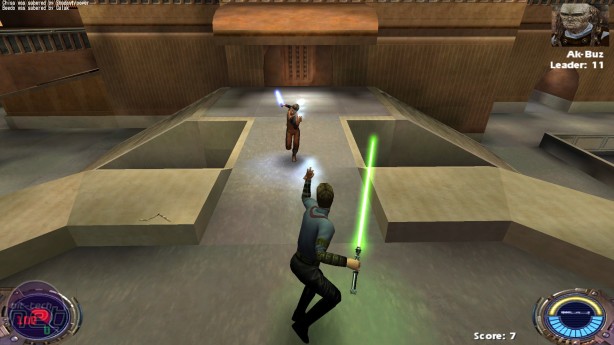
4. Dark Messiah: Might and Magic
When I was a kid, and used to think about what I'd do if I was rich, one of my more bizarre and indulgent ideas was to build a house entirely out of stunt materials: plywood walls, sugar glass windows and so forth, before inviting some friends around to have a massive fight in it. Part of me still wants to do this, but as I get older I increasingly realise that it would either A) be massively underwhelming or B) result in serious injury.
Thank goodness then for Dark Messiah: Might and Magic, which provides an entire fantasy realm seemingly constructed by Hollywood stunt coordinators. It's a world where the walls are liberally decorated with spikes perfect for kicking opponents into, and where patrolling enemies love nothing more to stand precariously on ledges or at the top of rickety staircases.
Dark Messiah is a swashbuckling simulator, and it has a combat system to match. Sword combat sees you actually bring your blade to your hip before swinging it, making strikes feel more controlled, more precise and more effective. Combine this with powerful and amusingly slapstick magic (try casting an ice spell near the feet of an enemy) and a kick that would make Bruce Lee green with envy, and you've got one of the most enjoyable action games around.
3. Batman: Arkham Asylum
Of all the games on this list, Rocksteady's first and best Batman simulator is also probably the most influential in terms of defining how to fit a combat system within a larger game. Subsequently aped by games like Sleeping Dogs and Shadow of Mordor, it's "freeflow" system of directional attacks and timed counters distils the nuances of melee combat into something immediately accessible and yet enduringly satisfying.
I put Asylum on this list not simply because it introduced this combat system, but because I also think it's the best implementation of it. Later Arkham Games such as City and Knight have their merits (like the pugilistic "Beatdown" manoeuvre first seen in City) but they're also too overcomplicated for my liking. Asylum, on the other hand, always finds a way to escalate the combat without overwhelming the player.
2. Dark Souls
So much has been written about Dark Souls' combat that it seems foolish to try to sum it up here. The incredible boss encounters, the precision of every strike, duck and roll, the way every enemy and environment finds new ways to test you, all of it is the subject of countless essays, editorials, analyses, even books.
Instead I simply want to highlight two little things Dark Souls does better than any other fighting game out there. The first is its attention to positioning and footwork. Where your character's feet are planted in Dark Souls has a profound effect on your success rate in combat. Remembering to circle your opponent enemy, to attack from the sides and avoid attacks with your short backwards dodge, is essential to emerging from a fight unscathed.
The other thing is the importance of your weapon's reach. There's a noticeable difference between fighting with a broadsword and fighting with a longsword. Meanwhile polearm's such as halberds are enormously useful for keeping enemies at bay, but useless if you allow them in too close. These and a dozen other reasons are why Dark Souls places second on this list.
1. Jedi Knight II: Jedi Outcast
Jedi Knight II is the best melee combat game ever made for two reasons, neither of which make sense at first glance. First of all, it's combat is based entirely around a weapon that doesn't exist. Secondly, it's a weapon that you don't even need to swing in order to kill an enemy with it.
Of course, once you delve a little deeper into Jedi Knight II's systems, it becomes clear that this makes perfect sense. The Star Wars universe allowed Raven software to ignore the normal rules of physics, and build a system that happily takes in its stride characters than can jump the height of a four-storey building and shoot lightning out of their fingers.
At the same time, the fact that the lightsaber is always active, rather than only being dangerous when it is swung, actually makes the combat far more interesting. It embraces the chaos that is a natural part of two people trying to slap each other with sticks, whether those sticks are laser-based or not.
The result is a game with duels that are more dynamic, more acrobatic, and more unpredictable than in any other game. Spectacular clashes of skill and agility sit alongside hilarious anticlimaxes where your opponent skewers himself on the point of your blade, or force-jumps into a chasm and plummets to his death.
Jedi Outcast also had a wonderful sense of escalation, gradually introducing you to tougher and tougher fights against it's force-infused Sith. The multiplayer, meanwhile, was so successful that there's still a small, dedicated community playing today. Jedi Outcast is an unmitigated triumph of design, and it never ceases to astound me that so few developers have emulated it since.
When I was a kid, and used to think about what I'd do if I was rich, one of my more bizarre and indulgent ideas was to build a house entirely out of stunt materials: plywood walls, sugar glass windows and so forth, before inviting some friends around to have a massive fight in it. Part of me still wants to do this, but as I get older I increasingly realise that it would either A) be massively underwhelming or B) result in serious injury.
Thank goodness then for Dark Messiah: Might and Magic, which provides an entire fantasy realm seemingly constructed by Hollywood stunt coordinators. It's a world where the walls are liberally decorated with spikes perfect for kicking opponents into, and where patrolling enemies love nothing more to stand precariously on ledges or at the top of rickety staircases.
Dark Messiah is a swashbuckling simulator, and it has a combat system to match. Sword combat sees you actually bring your blade to your hip before swinging it, making strikes feel more controlled, more precise and more effective. Combine this with powerful and amusingly slapstick magic (try casting an ice spell near the feet of an enemy) and a kick that would make Bruce Lee green with envy, and you've got one of the most enjoyable action games around.
3. Batman: Arkham Asylum
Of all the games on this list, Rocksteady's first and best Batman simulator is also probably the most influential in terms of defining how to fit a combat system within a larger game. Subsequently aped by games like Sleeping Dogs and Shadow of Mordor, it's "freeflow" system of directional attacks and timed counters distils the nuances of melee combat into something immediately accessible and yet enduringly satisfying.
I put Asylum on this list not simply because it introduced this combat system, but because I also think it's the best implementation of it. Later Arkham Games such as City and Knight have their merits (like the pugilistic "Beatdown" manoeuvre first seen in City) but they're also too overcomplicated for my liking. Asylum, on the other hand, always finds a way to escalate the combat without overwhelming the player.
2. Dark Souls
So much has been written about Dark Souls' combat that it seems foolish to try to sum it up here. The incredible boss encounters, the precision of every strike, duck and roll, the way every enemy and environment finds new ways to test you, all of it is the subject of countless essays, editorials, analyses, even books.
Instead I simply want to highlight two little things Dark Souls does better than any other fighting game out there. The first is its attention to positioning and footwork. Where your character's feet are planted in Dark Souls has a profound effect on your success rate in combat. Remembering to circle your opponent enemy, to attack from the sides and avoid attacks with your short backwards dodge, is essential to emerging from a fight unscathed.
The other thing is the importance of your weapon's reach. There's a noticeable difference between fighting with a broadsword and fighting with a longsword. Meanwhile polearm's such as halberds are enormously useful for keeping enemies at bay, but useless if you allow them in too close. These and a dozen other reasons are why Dark Souls places second on this list.
1. Jedi Knight II: Jedi Outcast
Jedi Knight II is the best melee combat game ever made for two reasons, neither of which make sense at first glance. First of all, it's combat is based entirely around a weapon that doesn't exist. Secondly, it's a weapon that you don't even need to swing in order to kill an enemy with it.
Of course, once you delve a little deeper into Jedi Knight II's systems, it becomes clear that this makes perfect sense. The Star Wars universe allowed Raven software to ignore the normal rules of physics, and build a system that happily takes in its stride characters than can jump the height of a four-storey building and shoot lightning out of their fingers.
At the same time, the fact that the lightsaber is always active, rather than only being dangerous when it is swung, actually makes the combat far more interesting. It embraces the chaos that is a natural part of two people trying to slap each other with sticks, whether those sticks are laser-based or not.
The result is a game with duels that are more dynamic, more acrobatic, and more unpredictable than in any other game. Spectacular clashes of skill and agility sit alongside hilarious anticlimaxes where your opponent skewers himself on the point of your blade, or force-jumps into a chasm and plummets to his death.
Jedi Outcast also had a wonderful sense of escalation, gradually introducing you to tougher and tougher fights against it's force-infused Sith. The multiplayer, meanwhile, was so successful that there's still a small, dedicated community playing today. Jedi Outcast is an unmitigated triumph of design, and it never ceases to astound me that so few developers have emulated it since.

MSI MPG Velox 100R Chassis Review
October 14 2021 | 15:04













Want to comment? Please log in.